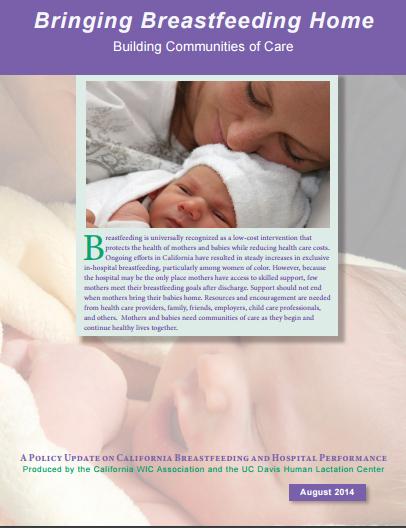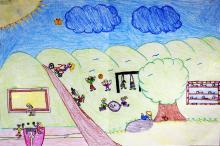|
Financial Literacy
The holiday season can be a time for increased financial stress. As many families still struggle to survive in this tough economy, support for their financial health is especially important. This month,
WIC Can Help
provide resources on debt counseling and financial literacy, from basic banking skills to foreclosure prevention and help with problem gambling.
|

Curbing Illness in the Workplace
'Tis the season when many of us battle colds and flus, and various illnesses get passed around schools and offices. Nobody likes to be sick, but staying home doesn't always feel like an option. Check
here for recommendations
from doctors - stay home is the obvious answer, but there are also precautions you can take if that's not possible.
|
Shopping at Amazon?
Support CWA without spending anything extra by using
AmazonSmile!
|
Did someone share this with you? Sign up here to get the CWA Flash directly!
|
|
 |
|

Giving Thanks for WIC
It has been an exceptional year in the US with many unexpected political changes, civic turmoil, social tragedies, and environmental disasters. Many California communities and local WIC agencies have been at the heart of some of these challenges, and will be experiencing the impact for years to come. An issue we often reflect on this time of year is poverty. Considering the high cost of living, California has the
highest poverty rate
including a very high rate of
children in living poverty
. To remain the Golden state we need a healthy and educated population and robust job market and economy. In spite of these issues, we can feel grateful for everyday heroes. There are many in our communities. When it comes to WIC, it is heartwarming to remember the daily contribution WIC employees make in communities across California - large and small, urban and rural, coastal, valley, mountain and desert regions - to ensure infants, children and their families have healthy foods and support, in those brief years before kindergarten. We are thankful for the health care providers and community members who link families to WIC, and grocers and farmers who ensure families are able to shop for their foods. When we think about forces that seem to be pulling us apart, we can also remember the WIC story which has for decades shown that by working together we can support our communities.
|

Annual Hospital Breastfeeding Fact Sheets are Coming!
Mothers who receive in-hospital support to breastfeed exclusively often continue to do so after discharge, paving the way for healthy infants, moms, and communities. Breastfeeding rates continue to rise for California hospitals, although disparities continue across racial and ethnic groups. ACTION:
Join us for a webinar
on December 6th to learn about the latest (2016) data and prepare for the release of new hospital breastfeeding state and county hospital breastfeeding rate fact sheets developed by California WIC Association, UC Davis Human Lactation Center, and California Breastfeeding Coalition.
|

California Nutrition Corp (CNC) Scholarships!
We are happy to announce that scholarship funds will be available this year for California WIC local and state employees who are in a dietetic internship or pursuing their undergraduate or graduate education in nutrition or public health. ACTION: The application is on our
CNC webpage
. Applications are open now, DUE January 15, 2018, and awards will be announced March 9, 2018.
|

Breastfeeding May Reduce Risk of Eczema
Breastfeeding could reduce the risk of eczema in children, according to new research. Researchers say that children whose mothers attended a hospital where a breastfeeding support program was implemented had a 54% reduction in the risk of eczema as teenagers. Data collected from 13,557 16-year olds, reveal that 0.3% of those whose mothers attended hospitals and clinics taking part in the educational initiative were found by experts to have signs of eczema, compared with 0.7% of those whose mothers had received only standard care. The study also reveals that 39% of mothers at sites where the educational program was implemented exclusively breastfed for between three and six months, compared to just over 6% of mothers who were not exposed to the program.
|

Americans Consuming Fewer Sugary Drinks
Sugar-sweetened drinks
have fallen in popularity
, according to a new study based on a continuing national health survey. 60.7 percent of children and 50 percent of adults drank a sugary beverage on any given day in 2014, down from 79.7 percent of children and 61.5 percent of adults in 2003. The study examined data from 18,000 children 2 to 19 years old, and 27,652 adults aged 20 and older. They were asked about their beverage consumption over the past 24 hours: juice, milk, sugar and diet soda, coffee and tea, sports drinks, water and alcohol. Soda consumption as well as 100 percent juice consumption both declined, and researchers attribute the decline to public education, changes in food allowances in federal nutrition programs, improvement in school lunch menus, and nutrition improvement of some foods by manufacturers, as well as some local taxes on sugar-sweetened beverages. Researchers also note that racial disparities in consumption of sweetened drinks persists.
|

New Hypertension Guidelines
|

New Guide on Public Benefits Linkages
Using information collected by one public benefit program to help enroll low-income people for other benefits for which they qualify makes programs more efficient and reduces hassles for struggling families. Recognizing this, Congress has provided requirements and options to use data gathered by one program in another. In some cases, a program can use another program's eligibility determination to eliminate a duplicative process. In other cases, a program can use data (such as income) that another trusted program has collected and verified to reduce burdens on state and local administrators and enable applicants to avoid having to provide the same paperwork to multiple offices. But the rules are specific and can be hard to navigate across multiple programs. This
guide,
provided by Social Interest Solutions and Center on Budget and Policy Priorities, is designed to help state and local policymakers and program officials identify opportunities under federal law to streamline the application and enrollment process. By relying on eligibility determinations made by other programs referred to as "linkages", for cross-enrollment opportunities, the guide can help stakeholders identify linkages they would like to establish or strengthen and find the details they need to implement them. An
interactive tool
to look at each program is also available.
|
National Prematurity Awareness Month
The CDC has released a
Fea
ture on premature birth
in honor of National Prematurity Awareness Month. The article highlights key information about preterm birth, risk factors, CDC activities, and helpful resources. The preterm birth rate rose for the second straight year in 2016, with about 1 in 10 babies born too early in the United States. Racial and ethnic disparities in preterm birth rates remain.
|
 Early Childhood Development and Community Safety
Early Childhood Development and Community Safety
The Prevention Institute and Center for the Study of Social Policy have released a series of publications through their project entitled
Cradle to Community: A Focus on Community Safety and Healthy Child Development
, exploring the linkages between community safety and child development as part of the joint Cradle to Community project. Resources include a fact sheet, issue brief, and research report as well as new videos on the Cradle to Community approach.
|
|
|